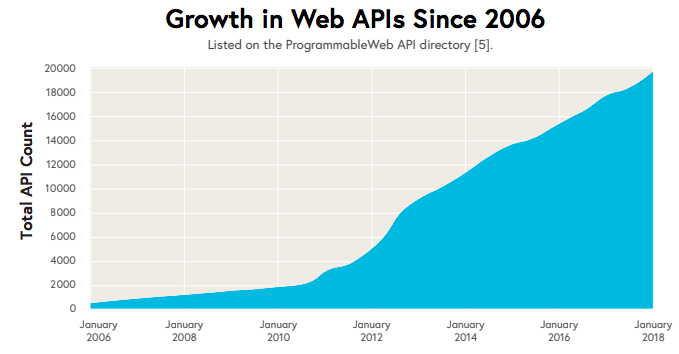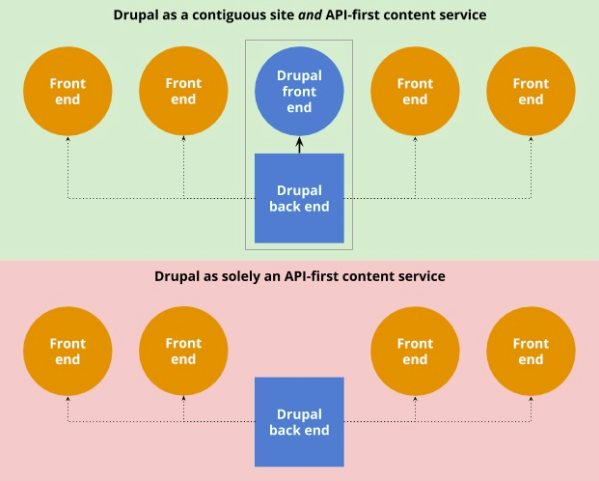Digitisation has altered the game for content providers. Customers - whether businesses or consumers - look for bite-sized pieces of content delivered to their chosen interface anywhere and anytime. Content creators continuously need to rethink and rewire how they disseminate content across channels due to the proliferation of digital platforms, the variety, and granularity of media, and the ever-shorter attention spans of customers. And so arises the need for a Content as a Service (CaaS) solution.

The democratisation of content and the entry of social media and the technology giants into the content business are erasing the divide between media and entertainment market segments. This is building a new ecosystem that will be driven by content-as-a-service delivery models. Drupal can offer a magnificent CaaS solution for the organisations looking to distribute content on screens, websites, mobile apps, IoT devices and beyond.
A Peek at CaaS

CaaS is an architectural pattern that completely decouples the content authoring process from how it is used. Traditional CMS offers a single software to separate the data layer from the presentation of said data. Even though the presentation of the data is separated, it is still attached to the technology, delivery channels, and the capabilities supported by the software. CaaS comprises of a backend CMS that provides content authoring capabilities with APIs for delivering content to external systems.
CaaS is an architectural pattern that completely decouples the content authoring process from how it is used.
An efficacious content-as-a-service model enables enterprises to store content in a form and with the sort of detail which makes it easier to discover, repurpose, transform, and transmit. Today, service providers can leverage their application programming interfaces (APIs) as platforms for disseminating content.
Simultaneously, organisations must consider the level of granularity that is needed to store and expose units of content in the most effective manner. They should track the business costs generated by individual units of content so that their content supply can be refined and new business models can be developed. Even though technology constraints must be duly assessed, content providers should understand their content’s ‘lowest common monetisation denominator’ (LCMD) and the returns on content assets.
Executing content as a service
CaaS is a paradigm for delivering the right amount of content to the right kind of customer at the right time via the right channel. That is:
- Content is enough to meet the demands of the customers
- Content is personalised
- Content is delivered accurately when the customer needs it. Updates are done in real-time.
- Content is delivered on the platform of choice at the right time and then swiftly and endlessly transferred from one platform/ device to another.
A perfect CaaS model is integrated with numerous services that connect to a customer-facing platform and expose units of content on demand. These can constitute music on Apple Music, books and magazines on Amazon Kindle, or shows on Netflix. The ubiquitous nature of the IoT is expected to make CaaS indispensable as all types of data are gathered by big data platforms and made available to application developers.
APIs are the drivers for most “X-as-a-service” ecosystems and content-as-a-service is no exception to this

With the increase in platforms, formats, devices, languages and locations for exposing content, the ease, speed, and efficacy of governing and delivering it must also increase. APIs can transmit data to and from any destination faster and with cost-effective ways. In the API economy, APIs are developed like products for supporting new business models. An API strategy is a collaborative effort among product and technology teams to keep a digital business strategy on track. APIs are the drivers for most “X-as-a-service” ecosystems and content-as-a-service is no exception to this.
The value of CaaS

The ability to precisely identify the smallest unit of content that can be stored autonomously and delivered profitably is the foundation of any CaaS model. This can be referred to as the lowest common monetisable denominator (LCMD) of content which can be tracked, tagged and reused. Through taxonomy and semantics, enterprises can store content at the LCMD level and develop an aggregate or smaller levels of the data on demand.
So once the organisation identifies the LCMD of content the evaluation can be done on the returns from pieces of content created at that granularity, that is, returns on a content asset (RoCA).
When can you use CaaS?
Following are the scenarios where you can utilise the capabilities of CaaS:
- Mobile applications: Alterations to mobile applications, most often than not, needs the application to be resubmitted to a digital distribution platform vendor like Google or Apple for the approval. CaaS system enables businesses to alter the content in these applications without having to change the application.
- Multiple channels: CaaS enables business users to deploy the same content to several delivery channels via a singular system rather than having to maintain different systems for different channels.
- UX flexibility: Being independent of the presentation layer, designers can freely use any technology to develop their UX and are not tied to technologies or components supported by the CMS. Javascript frameworks, that evolve at their own pace, provides developers with greater UX flexibility.
- AI-based application: Leveraging chatbots and other AI-based applications, it is easier for robots to consume content via an API.
Drupal as Content as a Service

If you want to enable your frontend developers to create engrossing customer experiences, Drupal’s content-as-a-service approach allows you to think outside the page-based mentality. Drupal’s CaaS solution helps in delivering reusable, future-proof content seamlessly by decoupling the back and front ends where needed.
Moreover, frontend developers can develop better experiences with Drupal’s presentation-neutral content and RESTful API and leverage tools like Angular, Ember, Backbone and many more. Ingestion of content from third-party content, for example, from aggregators and syndicators, to bring content into your Drupal environment can be done which can be disseminated to any channel. With Drupal’s CaaS capability, content is easily consumed by other websites and application that you choose.
It has all been possible because of the amazing work that is going on in the Drupal Community’s API-first initiative. It is actively working to advance existing and new web services web services efforts thereby making Drupal an excellent CaaS and optimal for developers. Through web services like JSON API and GraphQL or the tooling that accelerates headless application development like the Waterwheel ecosystem, Drupal as a content-as-a-service is great for developers.
Drupal is stupendous for both editors and developers
Drupal is stupendous for both editors and developers. The biggest advantage that Drupal has over its headless competitors is that it can be an amazing CMS for content editors to give them control over the presentation of their content and a rich headless CMS for enabling developers in building huge content ecosystems in a single package.
With Drupal perpetually powering more and more websites, it is also being extracted to its full potential in order to serve content to other backend systems, native applications, single page applications, and even conversational interfaces simultaneously.
Conclusion
As digital transformation accelerates, content providers are altering the nuts and bolts of their content activities. As more content is delivered as a service through a myriad of APIs, more data will get generated thereby assisting content providers in creating more precise business models.
Content as a service is like a treat for the developers giving them maximum flexibility in their pursuits of digital innovation. Drupal as a CaaS has been offering a great digital experience to both content editors and developers alike.
Drupal experts at Opensense Labs have been powering digital transformation of businesses through Drupal development.
Contact us at [email protected] to build great digital experiences using Drupal as Content as a Service.
Subscribe
Related Blogs
Inside the Drupal AI Summit: Themes, Speaker and What To Expect

“ The web is changing fast, and AI is rewriting the rules. It writes content, builds pages, and answers questions directly,…
FOST and Drupal AI Initiative: Next Era of Responsible AI

Three years after the launch of generative AI tools marked a new age for artificial intelligence, almost 90% of survey…
Drupal AI Ecosystem Part 5: AI Content Suggestions

Drupal has steadily evolved from being just a content management system into a flexible platform that incorporates emerging…




